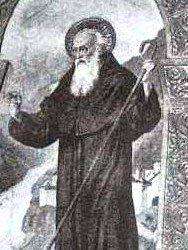Top Qs
Timeline
Chat
Perspective
March 10 (Eastern Orthodox liturgics)
From Wikipedia, the free encyclopedia
Remove ads
March 9 - Eastern Orthodox liturgical calendar - March 11

All fixed commemorations below are observed on March 23 by Eastern Orthodox Churches on the Old Calendar.[note 1]
For March 10th, Orthodox Churches on the Old Calendar commemorate the Saints listed on February 25 (February 26 on leap years).
Saints
- Martyr Codratus (Quadratus), and with him Martyrs Cyprian, Dionysius, Anectus, Paul, Crescens, and Dionysius (another), at Corinth (251)[1][2][3][4]
- Martyrs Victorinus, Victor, Nicephorus, Claudius, Diodorus, Serapion, Papias, and others, at Corinth (251 or 258)[1] (see also: January 31)
- Martyrs Codratus, Saturninus, and Rufinus, of Nicomedia (250-259)[1][5] (see also: March 7)
- Martyr Marcian, by scourging.[6][7]
- Saint Anastasia the Patrician, of Alexandria (567)[1][8][9]
- Saint George Arselaites (6th century)[1][7]
- Venerable Agathon, ascetic at the Monastery of St Symeon near Aleppo in Syria, reposed in peace.[10]
Remove ads
Pre-Schism Western saints
- Martyr Victor, in North Africa under Decius.[11][note 2]
- Saint Silvester (Sylvester), a companion of St Palladius in enlightening Ireland (c. 420)[11][13][note 3]
- Saint Simplicius, Pope of Rome (468-483), who upheld the decisions of the Council of Chalcedon against Monophysitism, and dealt with the Arian King Odoacer after the Fall of the Western Roman Empire in 476 (483)[11]
- Saint Droctoveus (Drotté), a disciple of St Germanus of Paris (c. 580)[11][12][15][note 4]
- Saint Kessog (Mackessog), an Irish missionary of the mid-sixth century active in the Lennox area and southern Perthshire (c. 560)[1][11][16][17][note 5]
- Saint Sedna (Sétna, Sidonius), Bishop of Ossory in Ireland and a friend of St Luanus (c. 570)[11][18][19]
- Saint Attalus (Attala), Abbot of Bobbio Abbey (626)[1][11][12][20][note 6]
- Saint Himelin, an Irish or Scottish priest who, returning from a pilgrimage to Rome, fell ill when passing through Vissenaken (c. 750)[11][21][22]
- Saint Emilian (Eminian), born in Ireland, he became a monk and then Abbot of Lagny (Abbaye Saint-Pierre de Lagny) in France (675)[11][23]
- Saint Failbhe the Little (Fáilbe mac Pípáin), Abbot of Iona in Scotland, where he reposed at the age of eighty (754)[11][24]
Remove ads
Post-Schism Orthodox saints
- Venerable John of Khakhuli Monastery, Georgia, called Chrysostom, reposed on Mount Athos (10th-11th century)[1][25][26][note 7]
- New Martyr Michael of Agrapha (Michael of Soluneia), at Thessalonica (1544 or 1547)[1][29][note 8] (see also: March 21)
- Saint Paul of Taganrog (Pavel of Taganrog) (1879)[1][7][note 9]
- Saint Alexander (Badanin), Priest, of Vologda (1913)[1][note 10]
New martyrs and confessors
Other commemorations
Icon gallery
- Saint Simplicius, Pope of Rome (468-483).
- Saint Attalus (Attala), Abbot of Bobbio Abbey.
- Saint Himelin.
Notes
- The notation Old Style or (OS) is sometimes used to indicate a date in the Julian Calendar (which is used by churches on the "Old Calendar").
The notation New Style or (NS), indicates a date in the Revised Julian calendar (which is used by churches on the "New Calendar"). - Palladius was accompanied by four companions: Sylvester and Solinus, who remained after him in Ireland; and Augustinus and Benedictus, who followed him to Britain, but returned to their own country after his death.[14] Palladius is most strongly associated with Leinster, particularly with Clonard, County Meath.
- A disciple of St Germanus of Paris, he became Abbot of St Symphorian in Autun in France. Later he was called back to Paris to be the first Abbot of St Vincent and the Holy Cross - afterwards renamed Saint-Germain-des-Prés.
- Born in Cashel in Tipperary in Ireland, even as a child he is said to have worked miracles. He became a missionary and preached in Scotland, where he became a bishop. According to one tradition he was martyred at Bandry. He is the patron-saint of Lennox.
- Born in Burgundy in France, he became a monk at Lérins. From there he went to Luxeuil with St Columbanus, whom he followed to Bobbio in the north of Italy, helping him to found the monastery there and succeeding him as abbot (615).
- He was burned alive on March 21, 1547 for his refusal to convert to Islam. However the Great Euchologion lists his feast day as March 10, 1544.[30]
- "A Ukrainian from Chernihiv, St Paul was a holy layman who lived at Taganrog to the east of the Black Sea. An ascetic who slept on a wooden board, he was constantly in prayer and would receive very many people who came to him for advice. Russian biographies of him note that he constantly spoke his native Ukrainian language. Today there is a Ukrainian embroidered "rushnyk" mantle-towel over the door of his home which is Taganrog’s greatest religious shrine."[31]
- See: (in Russian) Александр Вологодский. Википедии, (Russian Wikipedia).
Remove ads
References
Sources
Wikiwand - on
Seamless Wikipedia browsing. On steroids.
Remove ads





